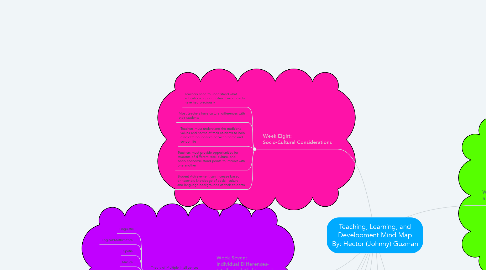
1. Week Four: Establishing a Positive Learning Environment
1.1. Three Fundamental Student Needs
1.1.1. To belong and feel connected
1.1.2. To feel autonomous and possess a sense of self-determination
1.1.3. To feel competent, successful, and accomplished
1.2. Ways for teacher to provide a positive learning environment
1.2.1. Partner with parents
1.2.2. Integrate positive classroom tasks
1.2.3. Address conflicts quickly and appropriately
1.2.4. Know your students
1.2.5. Be calm, fair, and consistent
1.2.6. Use a variety of communication methods
1.2.7. Inclusion of students when setting up classroom expectations
1.2.8. Design a safe, well-managed, and friendly classroom environment
1.2.9. Build a community
2. Week Three: Cognitive, Behavioural, Cognitive, and Constructivist Learning
2.1. Cognitive
2.1.1. How/why learning processes evolve and change over time
2.2. Behavioural
2.2.1. Focuses on objectively observable behaviours
2.3. Constructivist
2.3.1. Learning occurs when students are actively involved with their own learning
2.4. Social-Cultural
2.4.1. How students interact with each other and their differences culturally have an effect on their learning
3. Week Five: Making Instructional Decisions
3.1. Bloom's Taxonomy
3.1.1. Comprehension
3.1.2. Knowledge
3.1.3. Application
3.1.4. Synthesis
3.1.5. Analysis
3.1.6. Evaluation
3.2. Universal Instructional Design
3.2.1. Determine components to be taught
3.2.2. Create a welcoming/enjoyable classroom space
3.2.3. Implement a lot of different kinds of instructional strategies
3.2.4. Provide students with clear expectations and clear feedback
3.2.5. Provide a variety of ways for students to show what information they have retained
3.2.6. Use of appropriate technology
4. Week Six: Knowing That The Students Know
4.1. Backwards Design
4.2. Stiggin's Achievement Targets
4.2.1. Knowledge
4.2.2. Reasoning
4.2.3. Skills
4.2.4. Products
4.2.5. Attitudes and Dispositions
5. Week Seven: Individual Differences- Intellectual Abilities and Challenges
5.1. Theory of Multiple Intelligences
5.1.1. Linguistic
5.1.2. Logical/Mathimatical
5.1.3. Spatial
5.1.4. Musical
5.1.5. Bodily/Kinesthetic
5.1.6. Interpersonal
5.1.7. Intrapersonal
5.1.8. Naturalistic
6. Week Eight: Socio-Cultural Considerations
6.1. Teachers need to understand what educational oppurtunities their students have had previously
6.2. Most teachers have cultural differences with their students
6.3. Teachers must understand the traditional values and norms of their students to help eradicate boundaries between home and school life
6.4. Teachers must provide opportunities for students of different race, culture, and socio-economic stand points to interact with one another
6.5. Student Achievement can increase based on teachers knowledge of social, cultural, and language backgrounds of their students
7. Week One: Planning for the Upcoming School Year
7.1. Four Commonplaces in Education
7.1.1. Someone teaches something to someone else in some setting
7.2. Teacher Planning
7.2.1. What are you going to teach?
7.2.2. What is the order that it will be taught in?
7.2.3. What teaching methods/materials will be used?
7.2.4. What type of environment are you teaching in?
7.2.5. How and when will students be assessed?
7.3. Reflective Practice
7.3.1. Choosing to reflect on teaching in order to be an effective educator by reviewing and modifying lessons/teaching strategies
7.4. Research Mehods
7.4.1. Observation of Phenomena
7.4.2. Formation of questions
7.4.3. Application of Research Methods
7.4.4. Development of Guiding Principles
7.4.5. Development of Theories
8. Week Two: Considering Developmental Differences
8.1. Developmental Differences
8.1.1. Apply to all students in all grades
8.1.2. Exist not only among children in the same grade but also within some children
8.1.3. Provide teachers with foundational understandings of the learning process
8.2. Principales of Development
8.2.1. Follows an orderly and logical progression
8.2.2. Is a gradually progressive process but does not necessarily occur at a constant rate
8.2.3. Involves quantitative and qualitative changes
8.2.4. Individuals develop at different rates
8.2.5. Results from the combinatorial influences of genetics and the environment
9. Week Nine: Standardized Assessment
9.1. Purposes/Outcomes of Standardized Assessment
9.1.1. Monitors student achievement over time
9.1.2. Determines student performance
9.1.3. Holds teachers/administrators responsible
9.1.4. Allows identification and/or modification of successful instructional methods
9.2. Elements of Standardized Testing
9.2.1. Assessment process must not be intrusive on classrooms
9.2.2. Assessed knowledge has to be clearly described and must reflect students' learning
9.2.3. The curricular goals must be obtainable by students and teachable
9.2.4. Test must directly guide instruction
9.2.5. Test must assess important curricular goals

